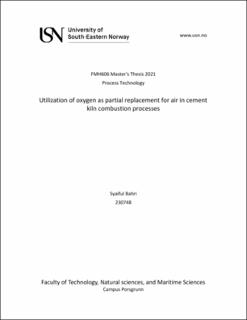Utilization of oxygen as partial replacement for air in cement kiln combustion processes
Master thesis
Permanent lenke
https://hdl.handle.net/11250/2774679Utgivelsesdato
2021Metadata
Vis full innførselSamlinger
Sammendrag
This thesis is started with introduction, continued with model building and its simulation results, then ended with economic analysis.
The idea of this study is to reduce the nitrogen content of the atmospheric air which is used in conventional combustion. Nitrogen, which is the biggest part of the air, consumes much energy released from fuel combustion as well as occupies the volume of the equipment. Theoretically, by decreasing the portion of the nitrogen in the combustion air, heat efficiency as well as equipment capacity can be increased.
The study is done by building mathematical model of heat and energy balance around the kiln and calciner of the existing cement plant then simulated at different oxygen level to get changes in fuel rate, exit gas flow rate, pure oxygen flow rate, and increase in capacity.
The study shows that there is heat efficiency at the kiln but reversely at the calciner. Increase in capacity is identified on both coal and waste fuel case when combustion air at kiln is partially replaced with oxygen. Economic analysis shows that implementation of utilization of oxygen as partial replacement for air in cement kiln combustion accompanied with capacity increase is profitable.
